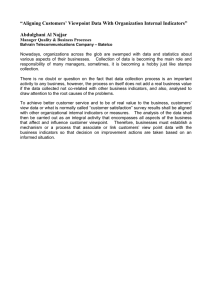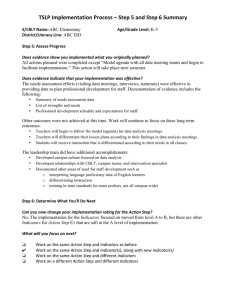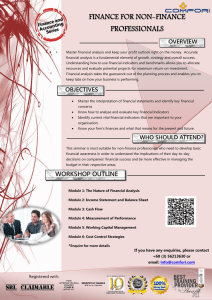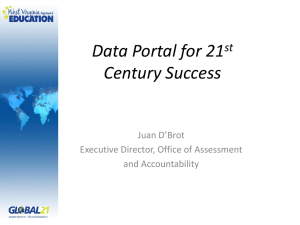Strategy Implementation, Monitoring & Evaluation
advertisement
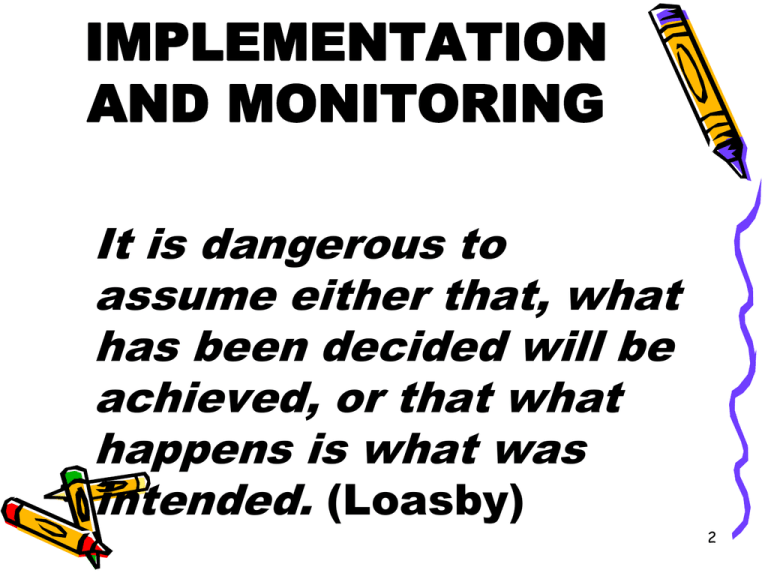
IMPLEMENTATION AND MONITORING It is dangerous to assume either that, what has been decided will be achieved, or that what happens is what was intended. (Loasby) 2 IMPLEMENTATION QUOTES ON IMPLEMENTING STRATEGY • We strategize beautifully, we implement pathetically. 3 IMPLEMENTATION Just being able to conceive bold new strategies is not enough. One must be able to translate his or her strategic vision into concrete steps that “get things done”. 4 IMPLEMENTATION • Organizing is what you do before you do something, so that when you do it, it is not all mixed up. • The strategy implementer’s task is to convert strategy into action to achieve the 5 IMPLEMENTATION targeted objectives Organizations don’t implement strategies, people do. 6 IMPLEMENTATION • Weak leadership can wreck the soundest strategy; forceful execution of even a poor plan can often bring victory • A leader lives in the field with his troops 7 IMPLEMENTATION • If you talk about change but don’t change the reward and recognition system, nothing changes. • While successful strategy making depends on vision, competitive analysis and entrepreneurial creativity 8 IMPLEMENTATION • Successful implementation depends on leading, motivating and working through others to create a strong fit between how the organization operates its business and the requirements for good strategy execution. 9 IMPLEMENTATION FRAMEWORK FOR IMPLEMENTATION • Build a capable organization • Develop budgets to steer resources 10 IMPLEMENTATION • Establishing appropriate policies and procedures • Instituting best practices and mechanisms for continuous improvement 11 IMPLEMENTATION • Installing support systems that facilitate carrying out of strategic roles • Tying rewards and incentives to achieving performance objectives 12 IMPLEMENTATION Framework conti---• Creating a strategy-supportive work environment and corporate culture • Exerting the internal leadership needed to drive implementation. 13 IMPLEMENTATION Effective strategy implementation requires three main fits • Between strategy and skills and competencies/capabilities 14 IMPLEMENTATION • Between strategy and organizational reward system, policies, systems and practices. • Between strategy and corporate culture The stronger the fits the higher the chances of success. 15 MONITORING • “Monitoring is the in-built mechanisms to check that things are going as per plan and to enable adjustments be made in a methodological way” Oxfam 1995 16 MONITORING • “Monitoring is the systematic and continuous assessment of the progress of a piece of work over time” SCF 1995 17 MONITORING • Monitoring is a management tool. Is the “regular collection and analysis of information for the surveillance of the progress of the project information”. 18 MONITORING Process Monitoring: Program monitoring should include info about the use of resources, the progress of activities & the way these are carried out. This is called Process Monitoring. 19 MONITORING Process monitoring is a means for: • Reviewing & planning work on a regular basis • Assessing whether activities are carried out as planned • Identifying & dealing with problems as they come up 20 MONITORING • Building on strengths & taking advantage of opportunities as they arise • Assessing whether the style of work & mgt is the best way to achieve the devt. objectives of the work (capacity building, etc.) 21 MONITORING Impact monitoring: Monitoring should also provide info on progress towards achieving objectives, and on the impact the program is having in relation to these objectives. 22 MONITORING • It is a form of continuous self evaluation & if done well, formal evaluation will be needed less often 23 MONITORING Impact monitoring is the means by which: • The work can be related to the overall purpose on a continuous basis, in order to provide a measure of progress 24 MONITORING • The work can be modified in response to changing circumstances without losing its overall direction 25 MONITORING • The need to change objectives can be identified • The need for further info or research can be identified • The assumption that the activities will help achieve the stated objectives can be verified. 26 MONITORING Designing a monitoring system: The essential components of a MS: 1. Defining the aim of the MS • Deciding who needs the MS & for what? • Setting objectives of the MS 27 MONITORING 2. Selection of relevant information • Selection of key indicators for each activity 3. The collection & analysis of data 28 MONITORING • Methods of collecting data • Collection of data concerning the indicators • What training & support is needed for the people collecting the data? 29 MONITORING • The analysis of the data 4. Presenting & using the results • Feedback & discussing the findings • Using the results for planning 30 MONITORING • Using the results for institutional learning • Using the results as a basis for evaluation or review 5. Organization • Deciding who should be involved in monitoring 31 MONITORING • Involvement of people from outside the program • Maintaining the MS: resources, training, support & supervision 32 MONITORING Impact: • Concerns long-term and sustainable changes in people’s lives brought about by a particular intervention 33 MONITORING • It can be related either to the specific objectives of an intervention or to unanticipated changes caused by an intervention 34 MONITORING • Unanticipated changes may also occur in the lives of the people not belonging to the beneficiary group • Impact can be either positive or negative; the latter being equally important to be aware of 35 MONITORING Impact assessment: Is the systematic analysis of the lasting or significant changes, positive or negative, intended or not – in people’s lives brought about by a given action or a series of actions. 36 MONITORING PERFORMANCE INDICATORS • What is it about? Expected results should always be accompanied by indicators. These are numbers; percentages; information obtained through interviews or analysis; 37 MONITORING in short units of measure, either quantitative or qualitative associated with each result in order to permit the tracking of progress 38 MONITORING • TIMING Monitoring is done through-out the progress of the programme to ensure controls in terms of • Quality • Quantity • Budget & Time 39

